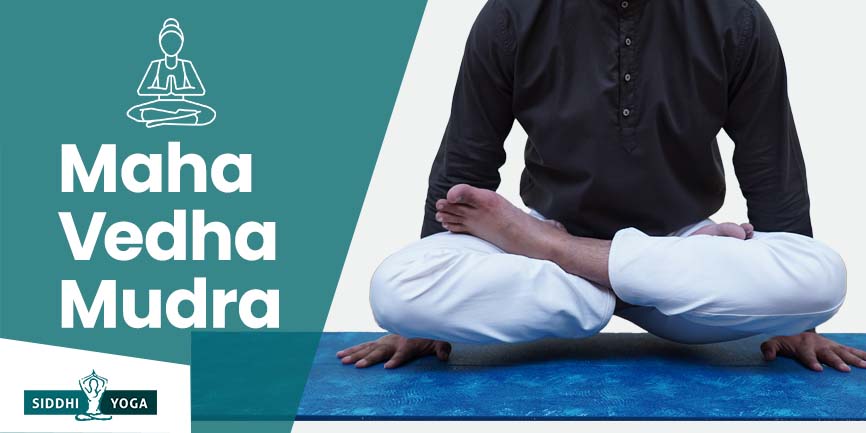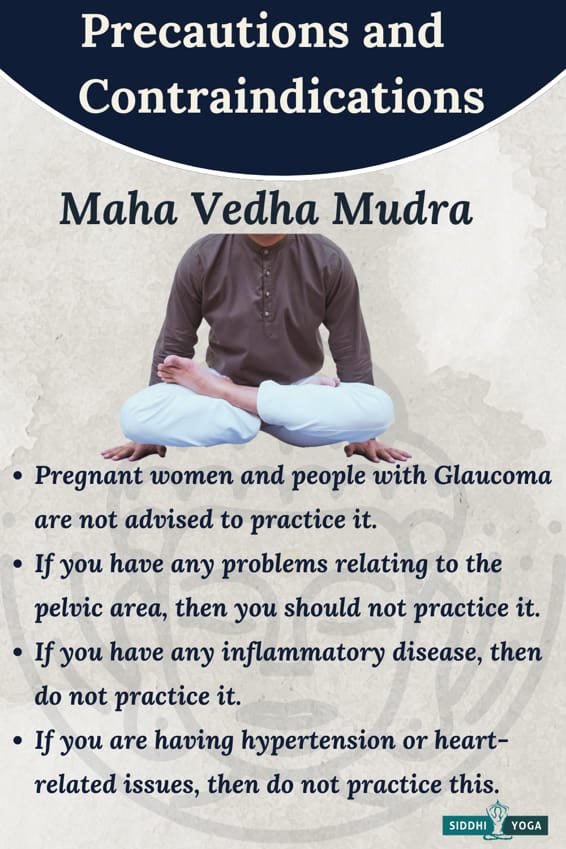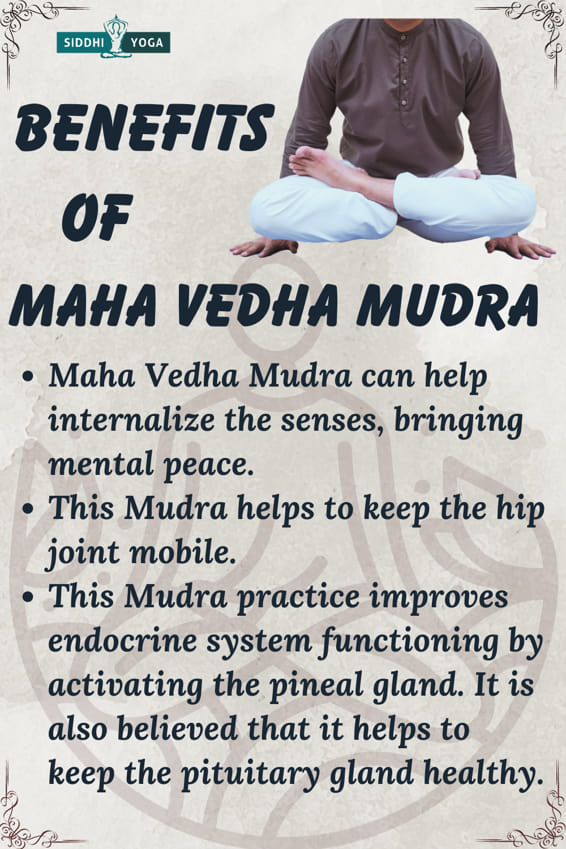
Learn the meaning of Maha Vedha mudra, its benefits, how to do it correctly, and why we should practice this Yoga Mudra.
Definition – What is Maha Vedha Mudra and its Meaning, References, and Mythology?
Maha Vedha Mudra is one of the physical Mudra or gestures/seals. Meaning this Mudra practice requires performing bodily postures. Let us simplify its meaning by breaking it down into simple parts:
Maha – the Sanskrit word “Maha” means “Great.”
Vedha – “Vedha” is a Sanskrit word that means “penetrating or piercing.”
Mudra – “Mudra” as we all know, can be translated into “a gesture or seal.”
This Mudra is also known as “The Great Piercing Mudra.” Maha Vedha and Maha Bheda seem quite similar but are two different gestures.
This Mudra helps to activate Kundalini Shakti by activating the Mooladhara Chakra (the root Chakra). This Mudra practice involves assuming body posture. This Mudra is more dynamic than most of the other Mudras. While practicing this Mudra, a Yogi assumes Maha Bandha as well, which we know is a combination of Three main Bandhas: Jalandhar Bandha, Uddiyana Bandha, and Moola Bandha.
This Mudra practice requires to have good mobility around the hip joints as this Mudra practice involves assuming Padma Asana for more effective results. Those who are tight from the hips might experience their knees lifting slightly off the floor, which should be minimized. You can practice hip mobility postures such as the Lizard Pose, Double pigeon Pose, Goddess Pose, etc. Practicing these postures will help to mobilize your hips. You can even try to live on the floor. Try to increase the time that you spend sitting on the floor. Due to the modern lifestyle, many people neglect such practices but avoiding this is sometimes compensated by the loss of hip mobility.
This posture also requires some good arm and core strength. So, practicing this Mudra can become tougher for those who lack such strength, which is why asana practice is also important to develop such strength.
This Mudra practice helps to increase the Prana energy flow in our body. Maha Vedha Mudra also helps to turn the mind inward.
Alternate Name of Maha Vedha Mudra
The Great Piercing Mudra.
How to Do Maha Vedha Mudra?
- In Maha Vedha Mudra, we practice specific dynamic movements, which is why it is considered more dynamic than all the Mudras. This Mudra practice specifically required good strength of arm and core muscles. And good hip joint mobility so that Padmasana can be assumed without difficulty.
- Start by sitting in Padma Asana (Lotus Pose). Extend your neck and spine.
- Take a few deep breaths and relax your entire body.
- Now, keep both of your arms by the side of your thighs. Palms are pointed forward and facing downward so that it would seem like you are gripping the floor with your fingers.
- Your arms and your shoulders should be relaxed.
- Now, slowly take a deep breath in.
- And retain your breath while you assume Jalandhar Bandha.
- Now, straighten your arms while lifting your entire body weight on your arm. Make sure to keep the spine comfortable, which Jalandhar Bandha should be maintained as it is.
- Keep your core and arm muscles active.
- Now, gently beat your buttocks down thrice while maintaining your entire concentration on the Mooladhara Chakra.
- Slowly and gradually release the Jalandhar Bandha, and then slowly release the Mudra.
- This was the first round of Maha Vadha Mudra.
- Practice it for a few more rounds once your breathing becomes normal again.
- You can assume all three Bandhas instead of Jalandhar Bandha. This will help to maximize the benefits.
Maha Vedha Mudra Benefits

- This Mudra practice is great to awaken the Kundalini Shakti or the Serpent Power.
- This Mudra practice help to activate the Mooladhara Chakra.
- As mentioned earlier, this Mudra is dynamic and helps tone up the shoulder and abdominal muscles.
- Maha Vedha Mudra can help internalize the senses, bringing mental peace.
- This Mudra helps to keep the hip joint mobile.
- This Mudra practice improves endocrine system functioning by activating the pineal gland. It is also believed that it helps to keep the pituitary gland healthy.
- If you want to follow a spiritual path, then this Mudra practice is a great way of doing so.
- Maha Vedha Mudra’s practice helps to delay the aging process.
Maha Vedha Mudra Precautions and Contraindications

- Make sure your neck, spine, and joints are healthy and mobile enough to practice this.
- Pregnant women and people with Glaucoma are not advised to practice it.
- If you have any problems relating to the pelvic area, then you should not practice it.
- If you have any inflammatory disease, then do not practice it.
- If you are having hypertension or heart-related issues, then do not practice this.
- If you have spine-related issues, then do not practice this.
When and how long to do Maha Vedha Mudra?
- If you want to awaken your Kundalini Shakti, practicing this will help.
- If you want to promote your endocrine system, this Mudra is very helpful.
- Maha Vedha Mudra’s practice helps keep the arms and core muscles active. So, practicing this Mudra can help improve your asana practices that involve such muscle activation.
Morning is the ideal time to do any yoga or Mudra. In the morning, during the daytime, our brain is at its best. So, you are more likely to be able to concentrate easily. Therefore, you should practice this Mudra from 4 am and 6 am to get the most effective outcomes.
If you are having difficulty with this during the morning hours, you can do this Mudra later in the evening too.
Practicing this Mudra for a minimum of 2-10 minutes daily is recommended. Whether you wish to complete it in one stretch or two threes that last between 2 and 5 minutes, it’s up to you. Based on research, the best way to practice an exercise for at least 20 minutes is to get the best benefits of that particular Mudra.
Breathing in Maha Vedha Mudra
To enhance your practice, you can practice breathing techniques with this Mudra.
- Deep breathing with breath retention is very important in this Mudra practice.
Affirmation in Maha Vedha Mudra
“I believe in divine consciousness, and everything will be fine.”
Conclusion
The Maha Vedha Mudra is an ancient yogic mudra or gesture with many benefits. It can improve circulation, help with headaches and migraines, and it even has the potential to prevent Alzheimer’s disease. If you’re interested in learning more about this Mudra and other mudras, we offer a Mudra certification course that covers all 108 Mudras. With our course, you’ll be able to learn about the history and origins of each Mudra, as well as how to perform them properly. Sign up today and start your journey to becoming a certified Mudra practitioner.